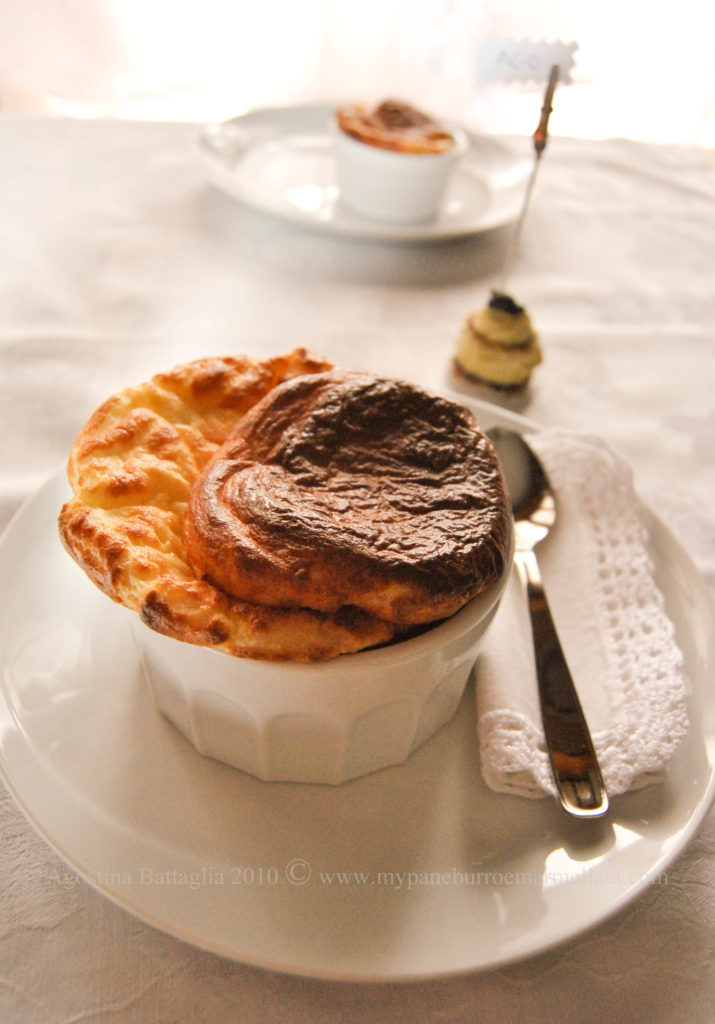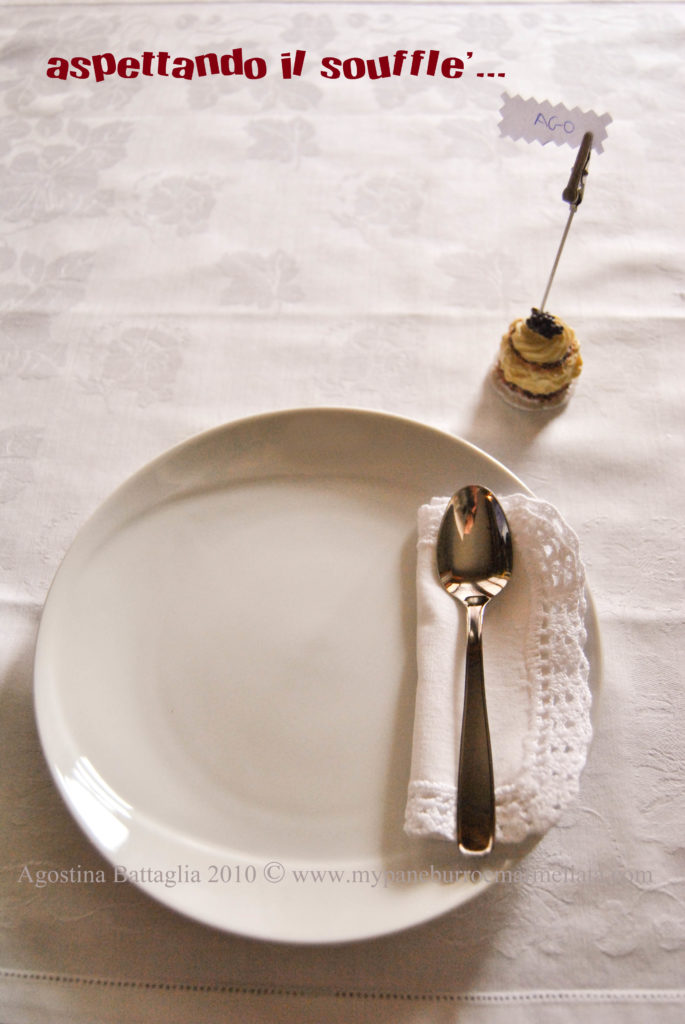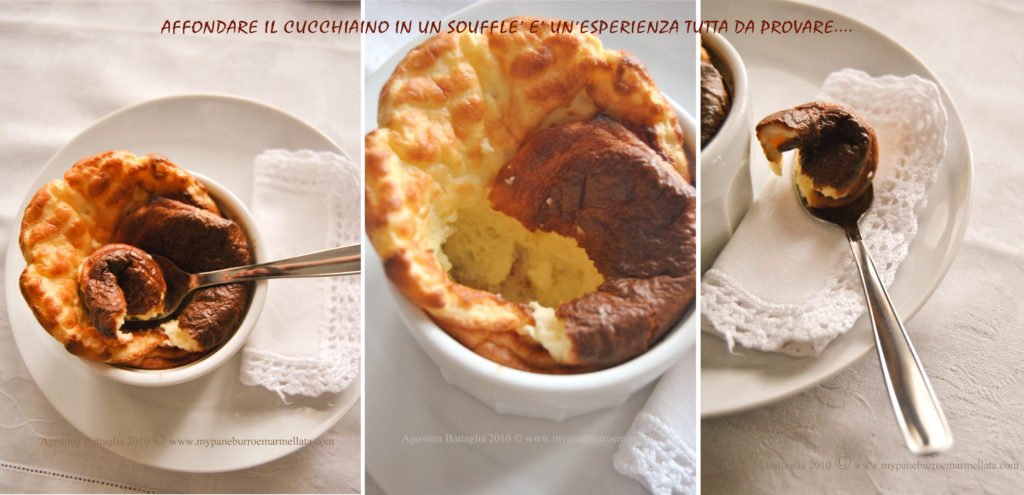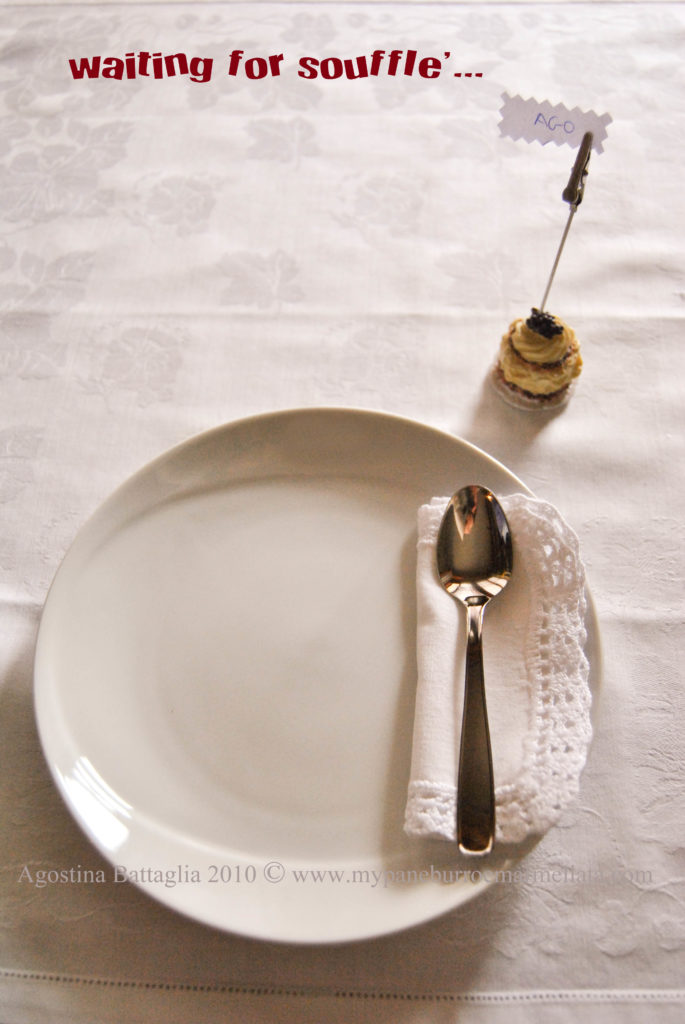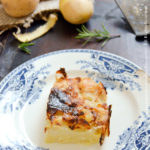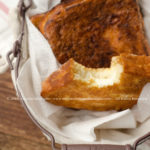Click here to read the English version
Avevo circa 11 – 12 anni ed una voglia disperata di provare, forse non tutte, ma la maggior parte delle ricette dolci che erano contenute nell’Enciclopedia “la Mia Cucina” che mia mamma custodiva gelosamente.
Dolci…ma non solo: diciamo che il panorama dei miei desideri spaziava dalla cioccolata calda in tazza del volume 2 a pagina 190 fino alla pasta sfogliata del volume 6 a pagina 73.
In mezzo a queste due preparazioni, l’una molto semplice, l’altra abbastanza difficile per una bimba di 11 anni, c’erano una miriade di altri dolcetti tradizionali e non, tra cui anche il soufflè.
Ce n’era uno in particolar modo, quello alle arance Haiti del volume 8 a pagina 218 che mi faceva proprio gola…le arance haiti, mai sentite nominare, ma non mi ero nemmeno posta il problema della loro esistenza…
Fatto sta che una mattina di vacanza dalla scuola mi misi di buona lena per cucinare questo soufflè: per quello che posso ricordare, fu una preparazione laboriosa, ma non soddisfacente, non gonfiò per niente ed il risultato finale avevo più l’aspetto di una frittata al forno che di un parente lontano dei Soufflès!
Non lo riprovai più, dichiarando guerra a queste preparazioni anomale e faticose…
Il soufflè quindi era uscito fuori dai miei pensieri, fino a quando non iniziai ad appassionarmi al cinema ed a vedere tutti i film che ne hanno fatto la storia.
Ci fu un film che mi riportò nel mondo dei soufflè: “Sabrina” con la bellissima Audrey Hepburn!
Guardando il movimento del polso per rompere un uovo (favoloso!) e la lezione di cucina francese sul soufflè, mi ricordai improvvisamente del mio soufflè…Ah, che disastro! 😀
E’ da qualche anno, quindi, che penso di riprodurre un soufflè, ma al formaggio o al cioccolato, non più alle arance di Haiti, che magari proverò a rifare un giorno o l’altro…Qui sait?
Questo mese, il gruppo dei Daring Cooks ha proposto come sfida del mese “il Soufflè” ed io ho solo preso la palla al balzo, lanciandomi finalmente e direi anche, nuovamente, in questa preparazione.
La mia ricetta non è tra quelle proposte, ma solo perchè volevo assaggiare il soufflè al formaggio e quindi, tra varie ricerche e letturine di ricette varie, sono giunta a questa che mi è sembrata abbastanza corretta.
Sono stata molto soddisfatta del risultato: il soufflè in forno, cresceva cresceva come una nuvola e tale è rimasto anche per qualche attimo dopo l’uscita dal forno…ma ha iniziato a sgonfiarsi inesorabilmente mentre scattavo le foto 🙁
1. il Soufflè è sicuramente tra i piatti più difficili da fotografare.
2. aveva ragione James Beard quando diceva:”La sola cosa che farà sgonfiare un soufflè è fargli sapere che tu hai paura di lui…”
Quindi, niente più paura di fare un soufflè…è troppo buono e morbido per aspettare ancora un attimo solo ad assaggiarlo! 😀
Soufflè au fromage
Ingredienti:
- 6 uova
- 6 cucchiai di farina
- 450 ml di latte
- 75 gr di burro
- 150 gr di Gruyère
- sale e pepe
Facciamo un roux, sciogliendo il burro e miscelando la farina. Diluire con il latte e far addensare sul gas. fare intiepidire ed aggiungere i tuorli, il formaggio grattuggiato, salare e pepare.
Montare l’albume a neve ben ferma ed unirlo al composto precedente.
Dividere il composto in sei ramekins, imburrati e cosparsi di formaggio grattugiato, ed infornare a 180° per 30 minuti o fino a che non è ben gonfio e colorito in superficie.
Servire immediatamente.
Il soufflé ha anche acquisito la reputazione di essere una preparazione tecnicamente impegnativa…non per niente, il soufflé, che non gonfia è uno stereotipo comune di disastro culinario.La ricetta del soufflè è solitamente composta da due parti: la base e gli albumi.
Per i soufflé salati, la base è di solito una salsa densa, ottenuta facendo un roux con burro e farina, diluito con latte o brodo a cui si aggiungono gli ingredienti aromatizzanti ed i tuorli.
Per quanto riguarda i soufflè dolci, la base è di solito una simil crema pasticcera, o crema densa. Gli albumi sono montati separatamente, in modo che incorporino molte bolle d’aria, e vengono aggiunti alla fine all’impasto base.
Con la cottura in forno, il soufflé gonfia magicamente.
Tuttavia, anche un soufflé perfetto inizierà a “sgonfiare” una volta che lo si rimuove dal forno ed è per questo motivo che lo si deve servire immediatamente.
Blog-checking lines: Dave and Linda from Monkeyshines in the Kitchen chose Soufflés as our November 2010 Daring Cooks’ Challenge! Dave and Linda provided two of their own delicious recipes plus a sinfully decadent chocolate soufflé recipe adapted from Gordon Ramsay’s recipe found at the BBC Good Food website.
Sweet … but not only say that the landscape of my desires ranging from the hot chocolate in book 2 on page 190 to the Puff Pastry, book 6 on page 73.
In between these two preparations, the one very simple, the other one quite difficult for a child , there were a mass of other traditional cakes and not, including the souffle.
There was one especially, the oranges Haiti souffle, volume 8 on page 218, that tempted me …
The fact is that a day of vacation from school I cooked this souffle: for what I can remember, it was a laborious preparation, but not satisfactory, not swollen at all and the end it was more like a baked omelette that a distant relative of Souffle!
I didn’t try again, declaring war on these unusual and hard preparation …
The souffle was then left out of my thoughts, until I began to get interested in the cinema and see all the films that have made its history.
There was a film that brought me into the world of souffles: “Sabrina” with the beautiful Audrey Hepburn!
Looking at the flick of your wrist to break an egg (wonderfull!) and the cooking class on French souffle, I suddenly remembered my souffle … Ah, what a mess! 😀
For some years, I expect to play a souffle, but the cheese or chocolate one, no more oranges from Haiti, that may try to redo a day or another … who know?
This month the Daring Cooks from Daring Kitchen have proposed as challenge of the month the soufflé, so I thought to try and cook a new soufflè!
My recipe is not proposed, but only because I wanted to taste the cheese souffle, and then, among different recipes, I tried this one.
I was very pleased with the outcome: the souffle in the oven, grew grew like a cloud and remains so even for a few moments after leaving the oven … but surely began to deflate while photographing 🙁
From this, there are two conclusions:
1. The soufflé is among the most difficult dishes to be photographed.
2. James Beard was right when he said: “The only thing that will make a soufflé fall is if it knows you are afraid of it…”
So, you aren’t afraid to make a soufflé … it’s too soft and good, don’t wait a moment to taste it! 😀
Souffle au fromage
Ingredients:
- 6 eggs
- 6 tbsp flour
- 450 ml milk
- 75 gr butter
- 150 gr Gruyère
- salt and pepper to taste
Let’s make a roux, melt the butter and mix the flour. Dilute with milk and thicken on the gas. Make it cool and add egg yolks, grated cheese, salt and pepper.
Beat the egg whites until stiff and add them to the batter.
Divide the mixture into six ramekins and bake at 180° for 30 minutes or until it’s very swollen and colorful on the surface. Serve it as soon as possible.
What’s Soufflè?
The word soufflé derives from the French verb souffler (or, if you prefer from the Latin sufflare, meaning to blow up/puff up) and properly made soufflés are light, ethereal creations with a creamy center. They are versatile and delicious, can be sweet or savory, and can serve as an appetizer, main course, side dish or dessert. However, soufflés have also acquired a reputation for being technically challenging, and the soufflé that doesn’t rise (or which rises but then collapses) is a common stereotype of culinary disaster.
There are basically two parts to a soufflé recipe: the base and the egg whites.
For savory soufflés, the base is usually a thick roux-based sauce made of butter, flour and milk or stock – to which you add the flavoring ingredients and the egg yolks.
Sweet soufflés are based on a crème patisserie, or thick custard.
The egg whites are beaten separately so that they incorporate lots of air bubbles; then the egg whites are folded into the base and the mixture spooned into a soufflé dish.
After baking in the oven, the soufflé will magically rise.
However, be warned that what goes up must come down: even a perfect soufflé will start to ‘deflate’ once you remove it from the oven – so be sure to serve it as soon as possible.

